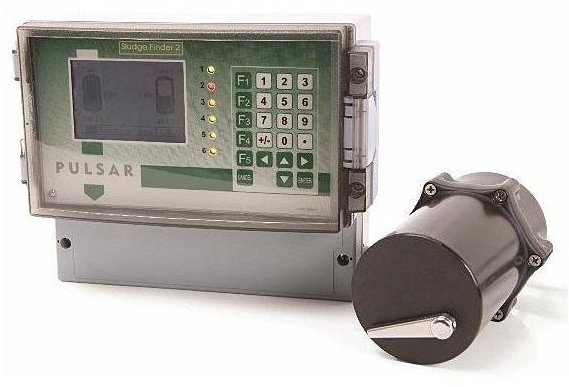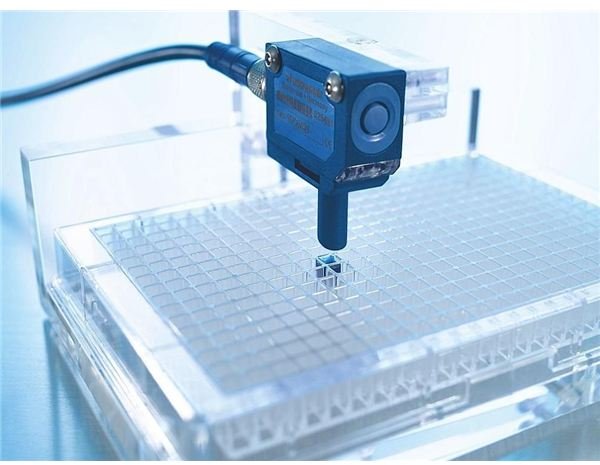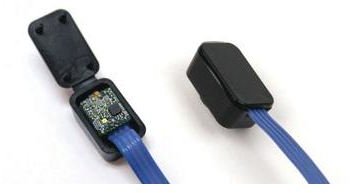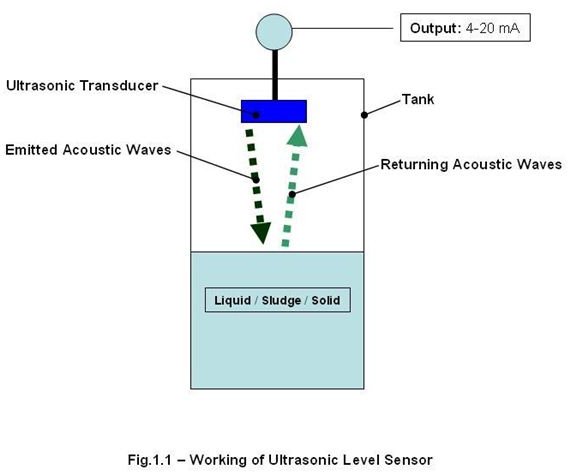Battery and DC Supply Powered Ultrasonic Level Sensors
How an Ultrasonic Level Sensor Works
- The transducer of an ultrasonic level sensor emits high frequency (20 - 200 kHz) acoustic waves.
- The emitted waves hit the liquid, sludge, or solid to be measured, and part of the emitting waves are reflected back to the transducer.
- From the time lag between the emission and the reflection of the acoustic waves, the level is measured.
- Results vary with varying levels of temperature, pressure, and humidity at the surrounding atmosphere. In other words, temperature, pressure, and humidity are the sources of error for these types of sensor.
Some Popular Ultrasonic Level Sensors
Mobrey® MSP900FH: This instrument is specially designed to work in open channel flow condition, as in measuring the level of an open flowing drain. It has a pre-wired remote temperature sensor, which reduces the error due to sunlight (caused by “solar gain”).

It has a 24 V DC powered transmitter unit hard wired with the transducer and has an operating range of 0.3 to 12 meter. The instrument works either with a MCU900 control unit or with a HART-compatible programming device.
Manufacturer: Emerson
UMC3000
This instrument is designed with the food processing industry in mind. It can give reasonably good results in a humid atmosphere. Its operating range is 0.2 to 3 meter.

The surface roughness of the housing is in the order of N6, making it a suitable candidate for applications where contamination is not desired. The design follows the European Hygienic Engineering & Design Group (EHEDG) guidelines. The unit operates with 10 – 30 V DC and produces switch or current output (4-20 mA), which means it can be used either as a level switch or as a level transmitter.
Manufacturer: Pepperl+Fuchs GmbH
Sludge Finder 2
This ultrasonic level sensor is used to monitor the height of sludge deposited below the liquid (technically termed as “sludge blanket interface”). The transducer unit is mounted immersing it in the fluid. The acoustic waves from the transducer are reflected back by the deposited sludge underneath the liquid.

The instrument is operated by 22 – 28 V DC and produces a 4-20 mA analog output signal respective to the height of the stored sludge from the tank bottom. The transducer unit is of a self-cleaning type. Working range for this instrument is 0.3 – 10 meter.
Manufacturer: Pulsar Process Measurements Limited
GuardScan50
This is a battery operated ultrasonic level sensor with an additional fuel theft alert feature incorporated in it. This system is ideal for unattended or remote fuel tanks. Apart from the fluid or solid level signals, it can generate signals for fuel (liquid) theft or sensor theft.

Operating range in case of liquid measurement is 0.4-12 meter and in case of solid is 0.4 – 8.5 meter. It works on 18 – 30 V DC and produces an output of 4-20 mA.
Manufacturer: Solid Applied Technologies Ltd.
Microsonic zws-15
This unit, if attached with a SoundPipe, is capable of measuring the level through a small hole (less than 3 mm diameter). It is used for measuring the levels in microplate wells used in the medical analysis field. It has operating range of 20 – 150 mm.

It works with operating voltage of 20 – 30 V DC and produces the output signals of 4-20 mA. The housing of the sensor is made up of ABS.
Manufacturer: microsonic gmbh
LifeGuard Series
The specialty of this level sensor is its tiny size and its disposable self-adhering mounting bracket. The device is capable of mounting over flat surfaces as well as curved surfaces.

The sensor is designed for far and near wall sensing of a reservoir. The working range is 7.6mm to 127 mm. The unit works with 2.7 – 5 V DC and produces a 5-20 mA output signal.
Manufacturer: MOOG Inc
Conclusion
The battery powered ultrasonic level sensor, a non-contact type sensor, is suitable for corrosion prone, hazardous, and maintenance free applications. The devices available in the market all work on the same basic principle of the generation and receiving of acoustic waves, but are different in their designs to fit within specific industrial applications. When selecting an ultrasonic level detector, one needs to check the possible application, working voltage, and operating range.
